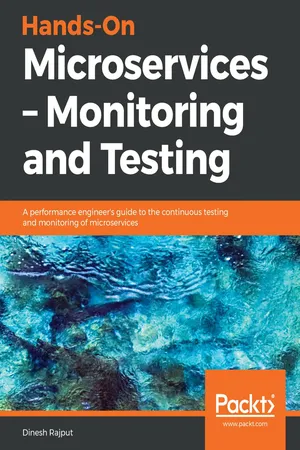
Hands-On Microservices – Monitoring and Testing
A performance engineer's guide to the continuous testing and monitoring of microservices
- 160 pages
- English
- ePUB (mobile friendly)
- Available on iOS & Android
Hands-On Microservices – Monitoring and Testing
A performance engineer's guide to the continuous testing and monitoring of microservices
About This Book
Learn and implement various techniques related to testing, monitoring and optimization for microservices architecture.
Key Features
- Learn different approaches for testing microservices to design and implement, robust and secure applications
- Become more efficient while working with microservices
- Explore Testing and Monitoring tools such as JMeter, Ready API, and AppDynamics
Book Description
Microservices are the latest "right" way of developing web applications. Microservices architecture has been gaining momentum over the past few years, but once you've started down the microservices path, you need to test and optimize the services. This book focuses on exploring various testing, monitoring, and optimization techniques for microservices.
The book starts with the evolution of software architecture style, from monolithic to virtualized, to microservices architecture. Then you will explore methods to deploy microservices and various implementation patterns. With the help of a real-world example, you will understand how external APIs help product developers to focus on core competencies.
After that, you will learn testing techniques, such as Unit Testing, Integration Testing, Functional Testing, and Load Testing. Next, you will explore performance testing tools, such as JMeter, and Gatling. Then, we deep dive into monitoring techniques and learn performance benchmarking of the various architectural components. For this, you will explore monitoring tools such as Appdynamics, Dynatrace, AWS CloudWatch, and Nagios.
Finally, you will learn to identify, address, and report various performance issues related to microservices.
What you will learn
- Understand the architecture of microservices and how to build services
- Establish how external APIs help to accelerate the development process
- Understand testing techniques, such as unit testing, integration testing, end-to-end testing, and UI/functional testing
- Explore various tools related to the performance testing, monitoring, and optimization of microservices
- Design strategies for performance testing
- Identify performance issues and fine-tune performance
Who this book is for
This book is for developers who are involved with microservices architecture to develop robust and secure applications. Basic knowledge of microservices is essential in order to get the most out of this book.
Frequently asked questions
Information
Inter-Service Communication
- Approaches to service communication:
- Synchronous communication
- Asynchronous communication
- Messaging
- Transactional messaging
- Event-based communication
- Microservice implementation patterns:
- The Command Query Responsibility Segregation pattern (CQRS)
- The Event Sourcing pattern
- The Eventual Consistency pattern
- Domain-specific protocols
Approaches to service communication

- The synchronous communication style
- The asynchronous communication style
Synchronous communication

REST

Table of contents
- Title Page
- Copyright and Credits
- Dedication
- Packt Upsell
- Contributors
- Preface
- Software Architecture Patterns
- Anatomy of Microservice Decomposition Services
- Microservices Deployment Patterns
- Inter-Service Communication
- Service Registry and Discovery
- External API Gateway
- Testing of Microservices
- Performance Testing of Microservices
- Performance Monitoring of Microservices
- Other Books You May Enjoy